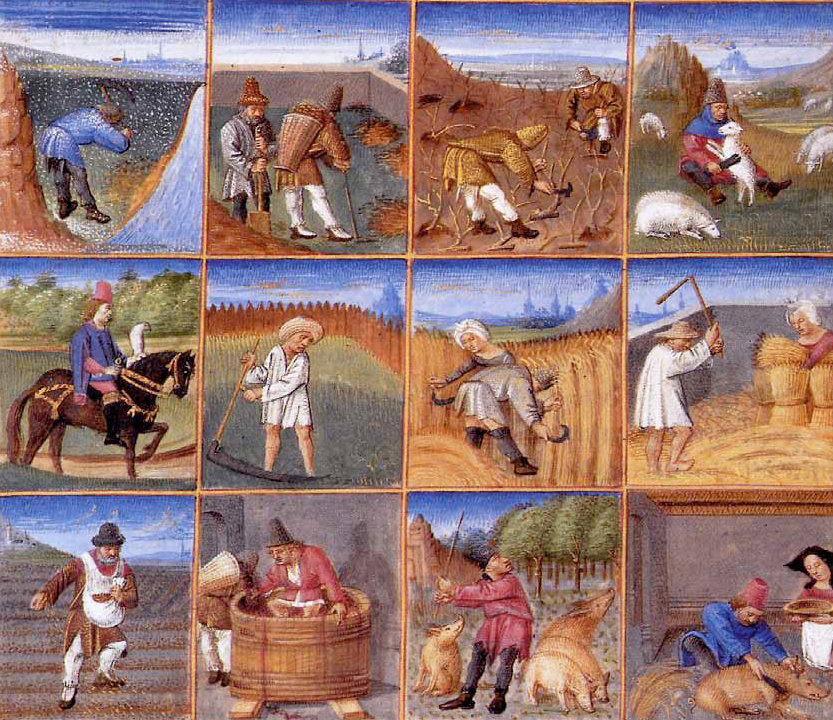Bruges, Belgium is a great example of a medieval historic settlement. Over 117,000 people live in the World Heritage Site of UNESCO. The town's golden age was between the 12th and 15th centuries, due to trade. The city became a major cloth-trading center by the late 13th century. It was mostly known for its textiles, lace, and wool. Bruges amassed so much wealth that upon visiting Bruges and seeing the wealthy people Queen Joanna of Navarre, King Philip the Fair's wife, stated "I thought I alone was queen, but I see that I have 600 rivals here".
In the 14th century, Bruges' prosperity grew as it became became a key member of the northern European trading routes via the Hanseatic league. Its location was critical since it was at the crossroads of the Hanseatic league trade and Southern trade routes. Furthermore, Italian cities were building trade houses there and exotic goods from all over Europe made their way to Bruges.
Unfortunately, the waterway linking Bruges to the sea silted up during the 15th century, killing the town's economic life. Nevertheless, tourism brought the city back to life at the start of the 19th century and has been the city's economic lifeline since.
Here is a list of the historical sites of Bruges:
Burg Square- this place was inhabited as early as the 2nd century AD. It became the base of operations of the Count of Flanders in the 9th century. The Palace of the Liberty of Bruges was the place from which the surrounding areas of the city was governed from the Late Middle Ages until 1775. In the square is also located the old Court of Justice and the Basilica of Holy Blood.
Markt- other medieval square dominated by its Belfry, the town's foremost edifice and therefore the perfect look-out for war and other catastrophes. It also contains the Provincial Palace, the statues of Bruges heroes Jan Breydel and Pieter de Coninck, as well as Waterhall, an old warehouse where goods were loaded and unloaded alongside the canals.
Sources
"Bruges". Wikipedia, 2015. https://en.wikipedia.org/wiki/Bruges
"Historic sites". Bezoekers. https://bezoekers.brugge.be/historicsites
"History of Bruges". Lonely Planet Information, 2015. http://www.lonelyplanet.com/belgium/flanders/bruges/history
In the 14th century, Bruges' prosperity grew as it became became a key member of the northern European trading routes via the Hanseatic league. Its location was critical since it was at the crossroads of the Hanseatic league trade and Southern trade routes. Furthermore, Italian cities were building trade houses there and exotic goods from all over Europe made their way to Bruges.
Unfortunately, the waterway linking Bruges to the sea silted up during the 15th century, killing the town's economic life. Nevertheless, tourism brought the city back to life at the start of the 19th century and has been the city's economic lifeline since.
Here is a list of the historical sites of Bruges:
Burg Square- this place was inhabited as early as the 2nd century AD. It became the base of operations of the Count of Flanders in the 9th century. The Palace of the Liberty of Bruges was the place from which the surrounding areas of the city was governed from the Late Middle Ages until 1775. In the square is also located the old Court of Justice and the Basilica of Holy Blood.
Markt- other medieval square dominated by its Belfry, the town's foremost edifice and therefore the perfect look-out for war and other catastrophes. It also contains the Provincial Palace, the statues of Bruges heroes Jan Breydel and Pieter de Coninck, as well as Waterhall, an old warehouse where goods were loaded and unloaded alongside the canals.
Huidenvettersplein (Tanner's Square)- tiny square adorned with restaurants and artists
Walplein- the name of this square refers to the first city walls built in 1127-28. Mostly known for its breweries and restaurants.
Jan van Eyckplein- square commemorating the renowned Bruges artist, Jan van Eyck. It used to be the old harbor of the city where ships loaded and unloaded their goods.
Simon Stevinplein- square named after the mathematician and physicist Simon Stevin. Until 1819, the square was the site of the Great Butcher's Hall and was owned by the Guild of Butchers.
Sources
"Bruges". Wikipedia, 2015. https://en.wikipedia.org/wiki/Bruges
"Historic sites". Bezoekers. https://bezoekers.brugge.be/historicsites
"History of Bruges". Lonely Planet Information, 2015. http://www.lonelyplanet.com/belgium/flanders/bruges/history










